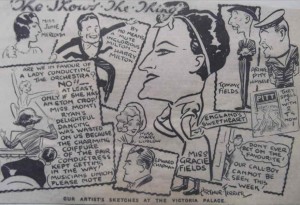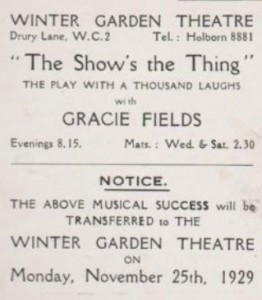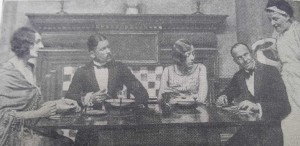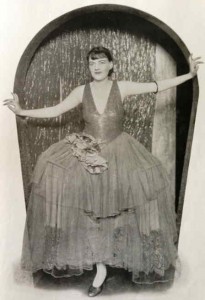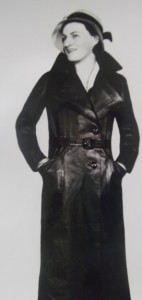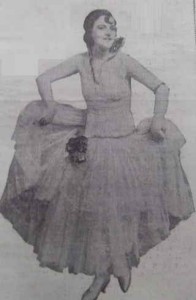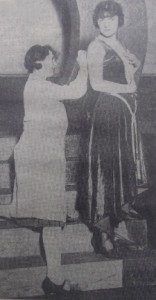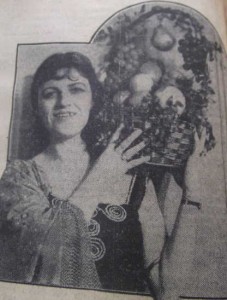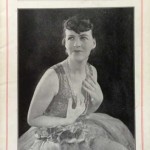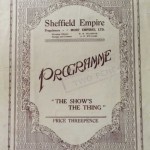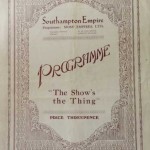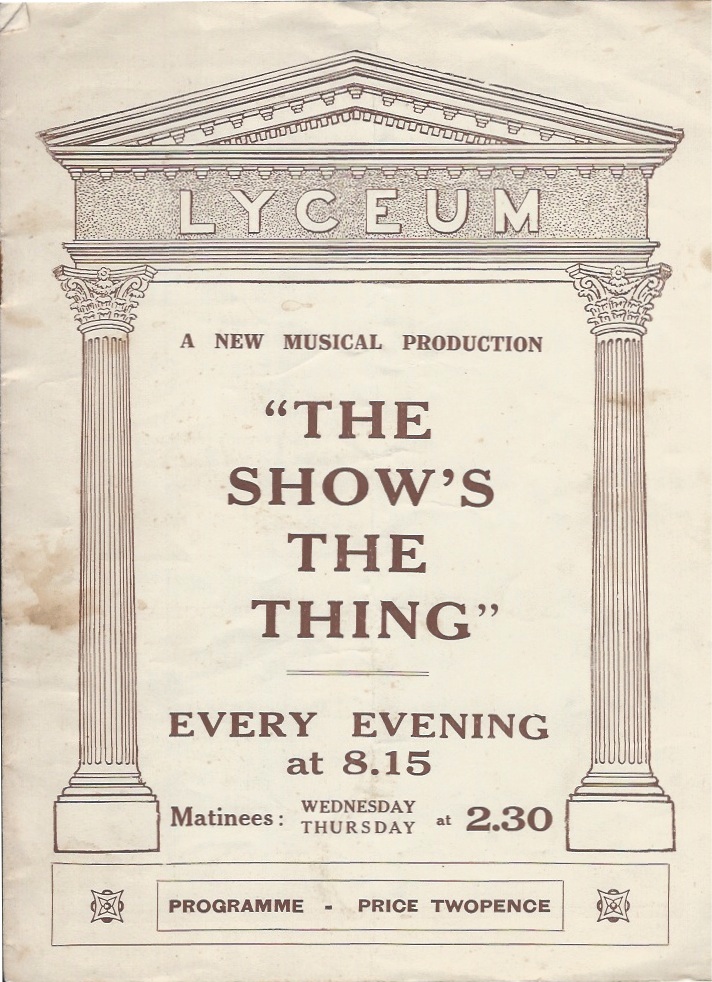Production work began on Archie Pitt’s show, ‘The Show’s the Thing’, in 1928. As with many of Archie’s productions, the show had a tour in the provinces before coming into the West End, It officially opened at the King’s Theatre, Southsea over Christmas 1928.
Running order for Sheffield, on the 18th March 1929
Act I
- The Fairground
- ‘Dancing Shoes’
- Gulliver’s Travels – Dining Room at the Banktops’ House
- ‘Clap Your Hands’
- Tommy Fields – ‘I wish she’d come along now’
- The Back Garden of the Bartholomew’s and the Spearmint’s
- ‘We’re not as bad as we’re painted’
- Gracie Fields
- ‘A Cute Little Flat’
Interval and selection by the Orchestra under the direction of Miss Annie Lipman
Act II
- A Spanish Inn
- The Village School Room
- A Railway Station
- ‘Terribly Fond of You’
- ‘Local Colour’ -The Kitchen
- Dance Away Your Blues
- The Big Top
Gracie variously featured as, The Lady With The Elastic Voice, The Maid Victoria, a Spanish Dancer, The Cleaner and even Archie’s daughter in one scene. The musical numbers listed for Gracie in the Sheffield performance are: ‘Laugh Clown Laugh,’ ‘I Love No-one But You‘ and ‘The Show’s the Thing.’ Although, it is likely she performed more numbers in her solo slot in Act One.
‘Copper Blues / Dancing Shoes’ – Ray Noble and his Orchestra
There were constant changes in the scenes and songs, honing it to perfection before it arrived in London. In the programme for Monday March the 3rd 1930 at the Southampton Empire, Gracie is listed as singing ‘Painting the Clouds with Sunshine’ in Scene 1. The following week at the Streatham Hill Empire Theatre, not many significant changes have taken place within the show. However, Gracie is given a duet dance number ‘Thank Heaven For You‘ with Monti Ryan in Act Two. The other changes are cast changes, and mainly a different violin solo for Tommy Fields and it presumably remained that way until the show opened in London.
Whilst rehearsing for the London run of the shows, Gracie and Archie had an argument over Gracie’s relationship with John Flanagan, as a result Gracie left the show two days before it was due to open and set off for Cannes, where Flanagan and Henry Savage were already holidaying. “I packed a small case quickly, and feeling like a criminal, I got a taxi to Victoria station and caught the boat-train for France.”
When Gracie arrived at Paris, a sense of guilt overwhelmed her and she rang home. Tommy Fields was upset as it was to be his first big break in London, so she rang Archie to ask if she could return home. He replied that he had ‘Never asked [her] to leave‘ and that she could come back if she wished. When she arrived home, Annie Lipman opened the door at Tower to her, greeting her with ‘I knew you’d come back.’
The show opened in London for a successful run at the Victoria Palace, but had to move out for the next variety show to move in. ‘The Show’s the Thing’ then transferred to the Lyceum Theatre, opening the 19th August 1929, before transferring again to the Winter Garden Theatre, Drury Lane. The show played three West End theatres, but ultimately was turned out of two of them, even though the Box Office was turning in more money than when the show went in.
Of the existent programmes we have for the London run, the musical numbers and scenes remain relatively the same for the production. The show ran for over a year in the West-End between the three theatres, and after the production closed Gracie took her holiday with Flanagan in the South of France, before moving on to Capri.
Whilst the show was playing at the Lyceum, Luisa Tetrazzini came to visit the show, and sent a note backstage asking if Gracie would sing part of La Traviata with her. Gracie guyed the song on stage as she did every night, throwing a wet dishcloth at the audience at the pinnacle of the aria, that night she rushed off stage to find Luisa in her dressing room.
“My dear’ she said, ‘oh, my dear, you must sing in opera, in good, great opera, not, not this…’ and with a wave of her hand she dismissed the whole Lyceum theatre.’ However, Gracie couldn’t be swayed.
—ooo0ooo—
A long but very interesting newspaper account of the show ……..
On Wednesday, December 26,1928, was produced, at the king’s, Southsea, by Archie Pitt, with book, dances, and ensembles by him, a musical play, in sixteen scene, entitled …
“The Show’s the Thing”
The Showman ….. Mr. Harry Milton
Beau Ideal ….. Mr. Tommy Field
Actor Laddie ….. Mr. Edward Chapman
Dancing Girl ….. Miss Monty Ryan
Bareback Rider ….. Miss Mary Ludlow
Heavy Lead ….. Miss June Meredith
Boxer ….. Mr. Archie Pitt
Lady with the Elastic Voice ….. Miss gracie fields
Mr. Archie Pitt is striking out on slightly new lines from his earlier successes in ‘The Show’s the Thing’ which, while described as a musical production, more strictly conforms to the title of revue, although there is only one absolutely straight scene. There is no connected story running through the production. Mr. Pitt, as he mentioned to an enthusiastic audience on the fall of the curtain on Boxing Night, has set out several twice-nightly revues, and this is his first attempt at a once-nightly review. ‘And the reason for that’, he added, ‘is that I want the West End of London to see Miss Fields in review’.
This versatile artist is the making of a brilliant show. She appears in seven of the sixteen scenes, in each of which Mr. Pitt has contrived to present her in a different class of setting, revealing the wide scope of her talent for singing and acting. Mr. Pitt also works hard throughout the show, and, in conjunction with Mr. Tommy Fields, imparts to it a capitol turn of humour. The whole production is staged and mounted in lavish style, with very fine scenic effects, the most charming of dresses, and the support of an exceptionally strong chorus both for the song and dance numbers. The lyrics and music, which are bright and tuneful, are by Gordon Courtney, and the show moves forward with brisk action.
The opening scene is the fairground, a setting full of life and colour, which serves to introduce the artists as indicated in the cast. This gives Miss Fields a most appropriate cue for a song, ‘Laugh, Clown, Laugh’, and is after the style of a prologue to the show. Her next appearance is in a little domestic comedy, ‘Gulliver’s Travels’, which provides her with some funny business as the temporary help engaged to wait at table for a dinner party of four. Contrast is afforded by Miss Fields’s next scene in which she has the stage to herself for the song, ‘We’re All Living at the Cloisters’, and other successes, which evoke loud applause.
In addition to supporting Miss Fields as the host in the comic item mentioned, Mr. Pitt appears with the other three artists, Miss Mary Ludlow, Mr. Edward Chapman, and Miss June Meredith in another amusing sketch, ‘Husbands and Wives’. The scene is laid in the adjacent back garden of a suburban ‘semi-detached’, with one husband patiently studying French and then German to suit his wife’s varying holiday moods, and ends on a startlingly explosive note, ‘We’re —– well, going to Southend’ when Russia is finally suggested. Mr Tommy Fields has a capitol solo turn in this half of the programme with the song, ‘I Wish She’d Come Along Now’, an eccentric dance, and a burlesque fiddle solo. ‘Like the Big Pots Do’, and also takes part with Mr. Harry Milton, Miss Dulcie le Blanc, and Miss Monti Ryan in another dance sketch, ‘Dancing Shoes’. Two smart chorus numbers are placed in between the big sets, ‘Clap Your Hands’, and ‘We’re Not So Bad As We’re Painted’, a very dainty concept, with artists engaged in swift decorative brushwork on the girls’ dresses during the opening verse. All the company re-appears for the musical sketch, ‘A Cute Little Flat’, presents a picturesque old village setting, with very effective entrances through an old walled archway, first for the honeymoon couple, Miss Monti Ryan and Mr. Harry Milton, and afterwards for Mr. Pitt and Miss Mary Ludlow as the sailor and his girl. The dresses, groupings, and dances in this scene are particularly good, and there is a decidedly humourous turn to the dialogue. Mr. Norman P Hackford was responsible for the lyrics and music of this sketch.
Another colourful setting of a Spanish Inn opens the second half of the programme, with a series of lively Spanish dances, and a delightful rendering of ‘I Love But You’ by Miss Gracie Fields, in her best sentimental style. A solo dance, ‘Al Sereno’, brings out all the skill and artistry of Miss Monti Ryan, and the closing serenade, ‘Carina’, by Mr. John David (a tuneful tenor), Miss Winnie Morgan, and the company provides a fitting finale for one of the best musical features of the show. Fun predominates in the succeeding sketch, ‘The Village School Room’, with Mr. Archie Pitt and Mr. Tommy Fields as a carpenter and his mate, and Miss Gracie Fields, as a cleaner with ambition to join the choir, practicing at the harmonium. Miss Fields, whose ‘best Lancashire French’ – her own description – provides a charming encore number in an earlier song scene, tries a little Welsh in this act with entertaining effect, and ends up by taking quiet a good part in the choir practice. The best feature of the next scene, ‘A Railway Station,’ in which a game of cards is exploited by Mr. Pitt and Mr. Tommy Fields as porters to fill in the lament of a girl in trouble in the musical number, ‘A Policeman is Not as blue as he Looks’, by Mr. Harry Milton and the full chorus of forty in police uniforms. The mass effect of which is excellent, and the number, which was so spiritedly rendered, was received with warm applause. Mr. Milton also appears with Miss Monti Ryan in the succeeding song-and-dance duet, ‘Terribly Fond of You’.
Miss Fields’s versatility is further revealed in the next scene, ‘Local Colour’. This is a little dramatic sketch of the east End, with Mr. Pitt as the old father, Miss Fields as the daughter, and Mr. Edward Chapman as the gentleman lodger. In the homely kitchen scene the old man rallies his daughter on taking to fancy speaking – she has been making a painstaking effort to pick up her aspirates – and learn that she has fallen in love with the lodger, whose attentions she had construed in her own way, an illusion heightened by the fact that he has something important to tell her before going away. The whole structure of her hopes collapses on learning that he is not an out-of-work clerk, but a dramatist who has been merely staying with them to study life in the East End as it really is. This is a poignant little scene, not overdrawn, and brings out Miss Fields’s talent for straight and emotional acting. A capital ‘Blues’ turn by Miss Monti Ryan, Mr. Tommy Fields, Mr. Harry Milton, and the girls precedes the finale, in which Miss Fields carries the audience to a pitch of enthusiasm by her fine rendering of ‘Ramona’, ‘My Ohio Home’, and other song numbers before being joined in the closing ‘Walk Up’ chorus by the full company.
There should be little doubt of the success of ‘The Show’s the Thing’. The whole company are smart and clever, the chorus admirable all through, and the show itself is bright, attractive and full of colour, with not a dull patch. There is no dragging about any of the scenes, and the personal charms of Miss Fields is enhanced by the delightful settings in which she finds herself. There is some good character acting by Mr. Archie Pitt, and Mr. Tommy Fields also establishes himself a warm favourite. Miss Monti Ryan’s dancing is an appreciated feature, and the supporting artists work hard. In addition to those already mentioned in the story, minor parts are filled by the Misses Hilda Farand, Billie Kennedy, Ethel Cook, Eve Samuel, Margot Howard, Dorothy Whitside, and Jean Allistone (the two last-named as dancers), Messrs. Peter Murray, Fred Heppell, and Arthur Coombes. Miss Annie Lipman skillfully directs the orchestra, which has been specially augmented for the show. Mr. Bert Aza is the general manager for Archie Pitt Productions, with Mr. Pat Aza as assistant producer. Mr. Gordon is acting as manager of the company, with Mr. Fred King as treasurer and secretary, Mr. George Jewett as stage manager, and Mr. Charles Needle as assistant stage manager.
—ooo0ooo—
- Winter Garden, London
- Sheffield Empire
- Southampton Empire
- Streatham Hill Theatre


